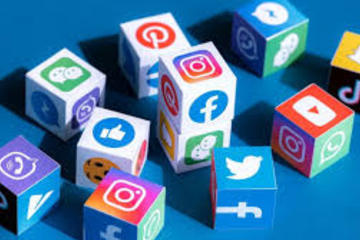We found 69 results that contain "communication"
Posted on: QA groups


Data communications
Data communications refers to the transmission of this digital data between two or more computers and a computer network or data network is a telecommunications network that allows computers to exchange data. The physical connection between networked computing devices is established using either cable media or wireless media. The best-known computer network is the Internet.
Posted on: QA groups


Data communications
Data communications refers to the transmission of this digital data between two or more computers and a computer network or data network is a telecommunications network that allows computers to exchange data. The physical connection between networked computing devices is established using either cable media or wireless media. The best-known computer network is the Internet.
Posted on: #iteachmsu


Communication to Support Student Learning in a Digital Learning Environment
What is communication (and what isn’t it)?
The P21 framework emphasizes effective use of oral, written, and nonverbal communication skills for multiple purposes (e.g., to inform, instruct, motivate, persuade, and share ideas). It also focuses on effective listening, using technology to communicate, and being able to evaluate the effectiveness of communication efforts—all within diverse contexts (adapted from P21). Note that working in partners is a great way to collaborate or build shared understanding but a critical part of communication is sharing with an authentic audience.
The P21 framework emphasizes effective use of oral, written, and nonverbal communication skills for multiple purposes (e.g., to inform, instruct, motivate, persuade, and share ideas). It also focuses on effective listening, using technology to communicate, and being able to evaluate the effectiveness of communication efforts—all within diverse contexts (adapted from P21). Note that working in partners is a great way to collaborate or build shared understanding but a critical part of communication is sharing with an authentic audience.
ASSESSING LEARNING
Posted on: #iteachmsu


Communication to Support Student Learning in a Digital Learning Environment
Educator provides evidence of their understanding of communication and outlines and provides evidence of a lesson that uses technology to support students’ use of communication in learning.
Posted on: #iteachmsu


Communication to Support Student Learning in a Digital Learning Environment
Educator provides evidence of their understanding of communication and outlines and provides evidence of a lesson that uses technology to support students’ use of communication in learning.
Posted on: #iteachmsu


Biology - Lesson 1
Key Points
Biology has evolved as a field of science since it was first studied in ancient civilizations, although modern biology is a relatively recent field.
Science is a process that requires the testing of ideas using evidence gathered from the natural world. Science is iterative in nature and involves critical thinking, careful data collection, rigorous peer review, and the communication of results.
Science also refers to the body of knowledge produced by scientific investigation.
Pseudoscience is a belief presented as scientific although it is not a product of scientific investigation
Biology has evolved as a field of science since it was first studied in ancient civilizations, although modern biology is a relatively recent field.
Science is a process that requires the testing of ideas using evidence gathered from the natural world. Science is iterative in nature and involves critical thinking, careful data collection, rigorous peer review, and the communication of results.
Science also refers to the body of knowledge produced by scientific investigation.
Pseudoscience is a belief presented as scientific although it is not a product of scientific investigation
NAVIGATING CONTEXT
Posted on: #iteachmsu


Playlist -- Management skills
WHAT IS MIS? | MANAGEMENT INFORMATION SYSTEMS
Management Information Systems (MIS) is the study of people, technology, organizations, and the relationships among them. MIS professionals help firms realize maximum benefit from investment in personnel, equipment, and business processes. MIS is a people-oriented field with an emphasis on service through technology. If you have an interest in technology and have the desire to use technology to improve people’s lives, a degree in MIS may be for you.
MIS PROFESSIONALS MAKE BUSINESS BETTER
Businesses use information systems at all levels of operation to collect, process, and store data. Management aggregates and disseminates this data in the form of information needed to carry out the daily operations of business. Everyone who works in business, from someone who pays the bills to the person who makes employment decisions, uses information systems. A car dealership could use a computer database to keep track of which products sell best. A retail store might use a computer-based information system to sell products over the Internet. In fact, many (if not most) businesses concentrate on the alignment of MIS with business goals to achieve competitive advantage over other businesses.
MIS professionals create information systems for data management (i.e., storing, searching, and analyzing data). In addition, they manage various information systems to meet the needs of managers, staff and customers. By working collaboratively with various members of their work group, as well as with their customers and clients, MIS professionals are able to play a key role in areas such as information security, integration, and exchange. As an MIS major, you will learn to design, implement, and use business information systems in innovative ways to increase the effectiveness and efficiency of your company.
MORE THAN CODING
A common misconception is that MIS only concerns coding (or writing computer code). While coding concepts represent some of the fundamental principles of information systems development, implementation, and use, many jobs in MIS do not utilize coding at all. A large portion of the MIS degree focuses on data analysis, teamwork, leadership, project management, customer service, and underlying business theories. These aspects of the degree are what set the MIS professional apart from a computer science specialist.
Do you enjoy working with people?
Would you enjoy the chance to work on global problems with people from all over the world?
Do you enjoy analyzing and solving problems?
Do you want to create innovative, cutting-edge technology solutions?
Do you want to learn how to make businesses more efficient, effective and competitive?
Then you should consider as your major the field that is experiencing a critical shortage of professionally trained individuals. A field where demand is skyrocketing with projected growth rates of 38 percent – the fastest of any business discipline (U.S. Bureau of Labor Statistics).
WHAT KINDS OF PEOPLE PURSUE MIS DEGREES?
The profiles of MIS professionals are varied, but in general, such individuals possess many of the following traits:
good problem solving skills
ability to effectively manage time and resources
a clear vision of “the big picture” as well as the “small details”
a desire to work closely with other people
excellent communication skills
ability to think strategically about technology
a desire to take responsibility for developing and implementing their own ideas
Management Information Systems (MIS) is the study of people, technology, organizations, and the relationships among them. MIS professionals help firms realize maximum benefit from investment in personnel, equipment, and business processes. MIS is a people-oriented field with an emphasis on service through technology. If you have an interest in technology and have the desire to use technology to improve people’s lives, a degree in MIS may be for you.
MIS PROFESSIONALS MAKE BUSINESS BETTER
Businesses use information systems at all levels of operation to collect, process, and store data. Management aggregates and disseminates this data in the form of information needed to carry out the daily operations of business. Everyone who works in business, from someone who pays the bills to the person who makes employment decisions, uses information systems. A car dealership could use a computer database to keep track of which products sell best. A retail store might use a computer-based information system to sell products over the Internet. In fact, many (if not most) businesses concentrate on the alignment of MIS with business goals to achieve competitive advantage over other businesses.
MIS professionals create information systems for data management (i.e., storing, searching, and analyzing data). In addition, they manage various information systems to meet the needs of managers, staff and customers. By working collaboratively with various members of their work group, as well as with their customers and clients, MIS professionals are able to play a key role in areas such as information security, integration, and exchange. As an MIS major, you will learn to design, implement, and use business information systems in innovative ways to increase the effectiveness and efficiency of your company.
MORE THAN CODING
A common misconception is that MIS only concerns coding (or writing computer code). While coding concepts represent some of the fundamental principles of information systems development, implementation, and use, many jobs in MIS do not utilize coding at all. A large portion of the MIS degree focuses on data analysis, teamwork, leadership, project management, customer service, and underlying business theories. These aspects of the degree are what set the MIS professional apart from a computer science specialist.
Do you enjoy working with people?
Would you enjoy the chance to work on global problems with people from all over the world?
Do you enjoy analyzing and solving problems?
Do you want to create innovative, cutting-edge technology solutions?
Do you want to learn how to make businesses more efficient, effective and competitive?
Then you should consider as your major the field that is experiencing a critical shortage of professionally trained individuals. A field where demand is skyrocketing with projected growth rates of 38 percent – the fastest of any business discipline (U.S. Bureau of Labor Statistics).
WHAT KINDS OF PEOPLE PURSUE MIS DEGREES?
The profiles of MIS professionals are varied, but in general, such individuals possess many of the following traits:
good problem solving skills
ability to effectively manage time and resources
a clear vision of “the big picture” as well as the “small details”
a desire to work closely with other people
excellent communication skills
ability to think strategically about technology
a desire to take responsibility for developing and implementing their own ideas
Posted on: #iteachmsu


Social media: what is?
social media refers to websites and applications that are designed to allow people to share content quickly, efficiently, and in real-time. While many people access social media through smartphone apps, this communication tool started with computers, and social media can refer to any internet communication tool that allows users to broadly share content and engage with the public.
ASSESSING LEARNING
Posted on: QA groups


Data communications
Data communications refers to the transmission of this digital data between two or more computers and a computer network or data network is a telecommunications network that allows computers to exchange data. The physical connection between networked computing devices is established using either cable media or wireless media. The best-known computer network is the Internet.
Posted by: Super Admin
Posted on: #iteachmsu


Home-School Collaboration, and Communication
Families are invaluable resources for teachers.
Websites: A homework website that provides assignments for the week is very helpful toparents and guardians of students with ADHD. Class news regarding projects and theweek’s instructional topics can also be posted.
Homework Hotline: A homework hotline that gives the assignments for the night andalso provides helpful suggestions for completing them can help families support theirchildren’s work completion.
We should emphasis a point here: ADHD is not caused by bad parenting
Causes for mental disorders are very difficult to pinpoint, but the general consensus is that they are products of the interaction of genetics with the environment.
Certain people who have genes that influence how the brain processes dopamine may be at increased risk for ADHD, but having the genes doesn’t necessarily mean a person will show signs of the condition.
Websites: A homework website that provides assignments for the week is very helpful toparents and guardians of students with ADHD. Class news regarding projects and theweek’s instructional topics can also be posted.
Homework Hotline: A homework hotline that gives the assignments for the night andalso provides helpful suggestions for completing them can help families support theirchildren’s work completion.
We should emphasis a point here: ADHD is not caused by bad parenting
Causes for mental disorders are very difficult to pinpoint, but the general consensus is that they are products of the interaction of genetics with the environment.
Certain people who have genes that influence how the brain processes dopamine may be at increased risk for ADHD, but having the genes doesn’t necessarily mean a person will show signs of the condition.
Authored by: Admin
Disciplinary Content
Posted on: Group 2


ADHD Students, Home-School Collaboration, and Communication
Families are invaluable resources for teachers.
Websites: A homework website that provides assignments for the week is very helpful toparents and guardians of students with ADHD. Class news regarding projects and theweek’s instructional topics can also be posted.
Websites: A homework website that provides assignments for the week is very helpful toparents and guardians of students with ADHD. Class news regarding projects and theweek’s instructional topics can also be posted.
Posted by: Vijayalaxmi Vishavnathkam Santosh Mali
Posted on: #iteachmsu


ADHD Students, Home-School Collaboration, and Communication - ADDED
ADHD Students, Home-School Collaboration, and Communication - ADDED
Families are invaluable resources for teachers.
Websites: A homework website that provides assignments for the week is very helpful toparents and guardians of students with ADHD. Class news regarding projects and theweek’s instructional topics can also be posted.
Families are invaluable resources for teachers.
Websites: A homework website that provides assignments for the week is very helpful toparents and guardians of students with ADHD. Class news regarding projects and theweek’s instructional topics can also be posted.
Posted by: Super Admin
Disciplinary Content
Posted on: #iteachmsu


Develop and actively communicate your course-level generative AI policy
1. Consider how AI technology might compel you to revise your course assignments, quizzes, and tests to avoid encouraging unethical or dishonest use of generative AI. 2. Develop and integrate a generative AI policy throughout the course resources:
Provide clear definitions, expectations, and repercussions of what will happen if students violate the policy.
Explain the standards of academic integrity in the course, especially as related to use of AI technologies, and review the Integrity of Scholarship and Grades Policy.
Be clear about what types of AI are acceptable and what versions of the technology students can use or not use.
Put this policy into D2L and any assignment instructions consistently.
3. Discuss these expectations when talking about course policies at the beginning of the course and remind students about them as you discuss course assignments:
Take time to explain to students the pros and cons of generative AI technologies relative to your course.
Explain the development of your policy and make clear the values, ethics, and philosophies underpinning its development.
Explain the repercussions of not following the course policy and submit an Academic Dishonesty Report if needed.
4. If you want to integrate AI in the classroom as an allowed or required resource:
Consult with MSU IT guidance about recommendations for use and adoption of generative AI technology, including guidelines for keeping you and your data safe.
Determine if MSU already has access to the tools you desire for free, and if not available through MSU, consider the cost and availability of the resources you will allow or require, and go through MSU's procurement process.
If you want to require students to use an AI technology that comes with a cost, put the resource into the scheduling system as you would a textbook, so students know that is an anticipated cost to them.
Provide clear definitions, expectations, and repercussions of what will happen if students violate the policy.
Explain the standards of academic integrity in the course, especially as related to use of AI technologies, and review the Integrity of Scholarship and Grades Policy.
Be clear about what types of AI are acceptable and what versions of the technology students can use or not use.
Put this policy into D2L and any assignment instructions consistently.
3. Discuss these expectations when talking about course policies at the beginning of the course and remind students about them as you discuss course assignments:
Take time to explain to students the pros and cons of generative AI technologies relative to your course.
Explain the development of your policy and make clear the values, ethics, and philosophies underpinning its development.
Explain the repercussions of not following the course policy and submit an Academic Dishonesty Report if needed.
4. If you want to integrate AI in the classroom as an allowed or required resource:
Consult with MSU IT guidance about recommendations for use and adoption of generative AI technology, including guidelines for keeping you and your data safe.
Determine if MSU already has access to the tools you desire for free, and if not available through MSU, consider the cost and availability of the resources you will allow or require, and go through MSU's procurement process.
If you want to require students to use an AI technology that comes with a cost, put the resource into the scheduling system as you would a textbook, so students know that is an anticipated cost to them.
Authored by: Super admin user
Posted on: #iteachmsu


Communication to Support Student Learning in a Digital Learning Environment
Key Method
Educator provides evidence of their understanding of communication and outlines and provides evidence of a lesson that uses technology to support students’ use of communication in learning.
Method Components
What are the 4Cs?
The 4Cs for 21st century learning are Creativity, Critical Thinking, Communication, and Collaboration. They are part of the framework for 21st Century Learning and are designed to support student learning in today’s world and are skills they can use in college and career.
What is communication (and what isn’t it)?
The P21 framework emphasizes effective use of oral, written, and nonverbal communication skills for multiple purposes (e.g., to inform, instruct, motivate, persuade, and share ideas). It also focuses on effective listening, using technology to communicate, and being able to evaluate the effectiveness of communication efforts—all within diverse contexts (adapted from P21). Note that working in partners is a great way to collaborate or build shared understanding but a critical part of communication is sharing with an authentic audience.
Educator provides evidence of their understanding of communication and outlines and provides evidence of a lesson that uses technology to support students’ use of communication in learning.
Method Components
What are the 4Cs?
The 4Cs for 21st century learning are Creativity, Critical Thinking, Communication, and Collaboration. They are part of the framework for 21st Century Learning and are designed to support student learning in today’s world and are skills they can use in college and career.
What is communication (and what isn’t it)?
The P21 framework emphasizes effective use of oral, written, and nonverbal communication skills for multiple purposes (e.g., to inform, instruct, motivate, persuade, and share ideas). It also focuses on effective listening, using technology to communicate, and being able to evaluate the effectiveness of communication efforts—all within diverse contexts (adapted from P21). Note that working in partners is a great way to collaborate or build shared understanding but a critical part of communication is sharing with an authentic audience.
Authored by: Greg
Assessing Learning
Posted on: #iteachmsu


Support Student Learning in a Digital Learning Environment
What is communication (and what isn’t it)?
The P21 framework emphasizes the effective use of oral, written, and nonverbal communication skills for multiple purposes (e.g., to inform, instruct, motivate, persuade, and share ideas). It also focuses on effective listening, using technology to communicate, and being able to evaluate the effectiveness of communication efforts—all within diverse contexts (adapted from P21). Note that working in partners is a great way to collaborate or build shared understanding but a critical part of communication is sharing with an authentic audience.
Example strategies that use technology to support communication in the classroom:
Host a TED-style conference or showcases for your students to present original ideas on a topic of interest to them to an authentic, external audience. Record and post the videos to a youtube stream.
Provide opportunities to listen and ask questions through backchannel tools like Today’s Meet or even Twitter.
Have your students publish their work through blogs, by creating websites, and by building other online resources that are shared with authentic audiences.
For other ideas see the resources below.
https://youtu.be/KUM4AECEcUA
The P21 framework emphasizes the effective use of oral, written, and nonverbal communication skills for multiple purposes (e.g., to inform, instruct, motivate, persuade, and share ideas). It also focuses on effective listening, using technology to communicate, and being able to evaluate the effectiveness of communication efforts—all within diverse contexts (adapted from P21). Note that working in partners is a great way to collaborate or build shared understanding but a critical part of communication is sharing with an authentic audience.
Example strategies that use technology to support communication in the classroom:
Host a TED-style conference or showcases for your students to present original ideas on a topic of interest to them to an authentic, external audience. Record and post the videos to a youtube stream.
Provide opportunities to listen and ask questions through backchannel tools like Today’s Meet or even Twitter.
Have your students publish their work through blogs, by creating websites, and by building other online resources that are shared with authentic audiences.
For other ideas see the resources below.
https://youtu.be/KUM4AECEcUA
Authored by: Friday Institute at NC State
Navigating Context
Posted on: #iteachmsu

Support Student Learning in a Digital Learning Environment
Educator provides evidence
of their understanding of communication and outlines and provides evidence of a lesson that uses technology to support students’ use of communication in learning.
Method Components
What are the 4Cs?
The 4Cs for 21st century learning are Creativity, Critical Thinking, Communication, and Collaboration. They are part of the framework for 21st Century Learning and are designed to support student learning in today’s world and are skills they can use in college and career.
What is communication (and what isn’t it)?
The P21 framework emphasizes effective use of oral, written, and nonverbal communication skills for multiple purposes (e.g., to inform, instruct, motivate, persuade, and share ideas). It also focuses on effective listening, using technology to communicate, and being able to evaluate the effectiveness of communication efforts—all within diverse contexts (adapted from P21). Note that working in partners is a great way to collaborate or build shared understanding but a critical part of communication is sharing with an authentic audience.
Example strategies that use technology to support communication in the classroom:
Host a TED-style conference or showcases for your students to present original ideas on a topic of interest to them to an authentic, external audience. Record and post the videos to a youtube stream.
Provide opportunities to listen and ask questions through back channel tools like Today’s Meet or even Twitter.
Have your students publish their work through blogs, by creating websites, and by building other online resources that are shared with authentic audiences.
For other ideas see the resources below.
of their understanding of communication and outlines and provides evidence of a lesson that uses technology to support students’ use of communication in learning.
Method Components
What are the 4Cs?
The 4Cs for 21st century learning are Creativity, Critical Thinking, Communication, and Collaboration. They are part of the framework for 21st Century Learning and are designed to support student learning in today’s world and are skills they can use in college and career.
What is communication (and what isn’t it)?
The P21 framework emphasizes effective use of oral, written, and nonverbal communication skills for multiple purposes (e.g., to inform, instruct, motivate, persuade, and share ideas). It also focuses on effective listening, using technology to communicate, and being able to evaluate the effectiveness of communication efforts—all within diverse contexts (adapted from P21). Note that working in partners is a great way to collaborate or build shared understanding but a critical part of communication is sharing with an authentic audience.
Example strategies that use technology to support communication in the classroom:
Host a TED-style conference or showcases for your students to present original ideas on a topic of interest to them to an authentic, external audience. Record and post the videos to a youtube stream.
Provide opportunities to listen and ask questions through back channel tools like Today’s Meet or even Twitter.
Have your students publish their work through blogs, by creating websites, and by building other online resources that are shared with authentic audiences.
For other ideas see the resources below.
Authored by: NC state
Disciplinary Content
Posted on: QA groups

Data communications refers to the transmission of this digital data between two or more computers and a computer network or data network is a telecommunications network that allows computers to exchange data. The physical connection between networked computing devices is established using either cable media or wireless media. The best-known computer network is the Internet.
Posted by: Super Admin
Posted on: #iteachmsu

What is communication (and what isn’t it)?
The P21 framework emphasizes effective use of oral, written, and nonverbal communication skills for multiple purposes (e.g., to inform, instruct, motivate, persuade, and share ideas). It also focuses on effective listening, using technology to communicate, and being able to evaluate the effectiveness of communication efforts—all within diverse contexts (adapted from P21). Note that working in partners is a great way to collaborate or build shared understanding but a critical part of communication is sharing with an authentic audience.
REF:What is communication (and what isn’t it)?
The P21 framework emphasizes effective use of oral, written, and nonverbal communication skills for multiple purposes (e.g., to inform, instruct, motivate, persuade, and share ideas). It also focuses on effective listening, using technology to communicate, and being able to evaluate the effectiveness of communication efforts—all within diverse contexts (adapted from P21). Note that working in partners is a great way to collaborate or build shared understanding but a critical part of communication is sharing with an authentic audience.
The P21 framework emphasizes effective use of oral, written, and nonverbal communication skills for multiple purposes (e.g., to inform, instruct, motivate, persuade, and share ideas). It also focuses on effective listening, using technology to communicate, and being able to evaluate the effectiveness of communication efforts—all within diverse contexts (adapted from P21). Note that working in partners is a great way to collaborate or build shared understanding but a critical part of communication is sharing with an authentic audience.
REF:What is communication (and what isn’t it)?
The P21 framework emphasizes effective use of oral, written, and nonverbal communication skills for multiple purposes (e.g., to inform, instruct, motivate, persuade, and share ideas). It also focuses on effective listening, using technology to communicate, and being able to evaluate the effectiveness of communication efforts—all within diverse contexts (adapted from P21). Note that working in partners is a great way to collaborate or build shared understanding but a critical part of communication is sharing with an authentic audience.
Posted by: Chathuri Super admin..
Navigating Context
Posted on: #iteachmsu
![Article preview image]()
Lorem Ipsum is simply dummy text of the printing and typesetting industry. Lorem Ipsum has been the industry's standard dummy text ever since the 1500s, when an unknown printer took a galley of type and scrambled it to
Posted by: Chathuri Super admin..
Posted on: #iteachmsu


Educator provides evidence of their understanding of communication and outlines and provides evidence of a lesson that uses technology to support students’ use of communication in learning.
https://microcredentials.digitalpromise.org/explore/communication-to-support-student-learning-in-a-dig
https://microcredentials.digitalpromise.org/explore/communication-to-support-student-learning-in-a-dig
Posted by: Chathuri Super admin..
Posted on: #iteachmsu

The P21 framework emphasizes effective use of oral, written, and nonverbal communication skills for multiple purposes (e.g., to inform, instruct, motivate, persuade, and share ideas). It also focuses on effective listening, using technology to communicate, and being able to evaluate the effectiveness of communication efforts—all within diverse contexts (adapted from P21). Note that working in partners is a great way to collaborate or build shared understanding but a critical part of communication is sharing with an authentic audience.
Posted by: Chathuri Super admin..
Pedagogical Design
Posted on: #iteachmsu
![Article preview image]()
One thing immediately jumps out: Only one of the 13 questions, question No. 9, asks employees to rate their manager's hard skills.
Every other question focuses on soft skills: communication, feedback, coaching, teamwork, respect, and consideration. The evaluation predominately assesses not what managers know but how they do their jobs.
Which means the best managers add value by helping their teams succeed -- their success comes from the team's, and each individual on that team's, success.
Of course, you could argue that possessing superb technical skills is less important for Google's team managers since it's easier for Google to recruit and retain incredibly skilled people than it is for many companies.
Every other question focuses on soft skills: communication, feedback, coaching, teamwork, respect, and consideration. The evaluation predominately assesses not what managers know but how they do their jobs.
Which means the best managers add value by helping their teams succeed -- their success comes from the team's, and each individual on that team's, success.
Of course, you could argue that possessing superb technical skills is less important for Google's team managers since it's easier for Google to recruit and retain incredibly skilled people than it is for many companies.
Posted by: Chathuri Super admin..
Assessing Learning
Posted on: #iteachmsu

Looking back thousands of years we can find components of organizational behavior. Famous philosophers like Plato and Aristotle discussed key components of today’s organizations including the importance of leadership and clear communication. While these seem like very basic and broad concepts today, at the time they were innovative ideas and helped to lay the foundation for organizational behavior.
Posted by: Chathuri Super admin..
Disciplinary Content
Posted on: #iteachmsu

Classroom norms. Norms and expectations should take into account different cultural and communication styles, gender differences, language needs, and the desire to challenge stereotypes. Students should be involved in setting classroom norms to generate buy-in.
Posted by: Chathuri Super admin..
Disciplinary Content
Host: CTLI

Setting the Tone from the Start
The way a course begins is crucial for educators to establish an environment that fosters engagement, collaboration, and a sense of belonging. Join us for a one-hour hybrid workshop where Educator Developers with MSU's Center for Teaching and Learning Innovation will share actionable strategies that lay the groundwork for an engaging and inclusive course experience from day one including items related to syllabi, expectation setting and pedagogical transparency, checking in on learner needs throughout the term, and way to build a sense of classroom community.
In this workshop, we'll delve into practical techniques and approaches educators can employ to create a welcoming and motivating atmosphere that resonates with learners. The content in this workshop will be primarily targeted to classroom instructors and settings, but tools and strategies are relevant for adaptation and use by any educator in any context. Whether you're a seasoned educator or just embarking on your teaching journey this academic year, "Setting the Tone from the Start" is designed to equip you with actionable insights that will make a difference in your classroom.
Upon completion of this learning experience, participants will be able to:
learn how to craft an engaging and purposeful course introduction that communicates the course's relevance, objectives, and expectations
discover techniques for fostering an inclusive and supportive learning community, understanding how to encourage peer connections and embrace diverse viewpoints
be equipped with a range of interactive strategies, including icebreakers and technology tools, to effectively engage students and cultivate an active learning environment that persists throughout the course duration.
The in-person location for this session is the Center for Teaching and Learning Innovation. Please join us in the Main Library, Room W207. For directions to W207, please visit the Room Locations page..
Navigating Context
EXPIRED
Host: CTLI

Supporting Student Success Through Early Warning: Strategies for Graduate Teaching Assistants
On behalf of the GREAT office at The Graduate School, check out Supporting Student Success Through Early Warning: Strategies for Graduate Teaching Assistants
Date: Wednesday, September 10, 2025 - 11:00am to 12:00pm
Location: Zoom
Audience: Current Graduate Students & Postdocs
This interactive session is designed to support Graduate Teaching Assistants in recognizing and responding to early signs that students may be in need of support. Participants will explore their role in MSU’s early warning efforts and develop practical strategies to promote academic engagement, connection, and timely support. The session will include discussion of common indicators that students may be facing challenges affecting their educational success, strategies for effective communication, and how to use campus resources and reporting tools like EASE to provide timely support.
Facilitator(s):
Kanchan Pavangadkar, Director of Student Success for the College of Agriculture and Natural Resources (CANR)
Dwight Handspike, Director of Academic Advising & Student Success Initiatives, Undergraduate Academic Services, Broad College of Business
Samantha Zill, Human Biology & Pre-Health Advisor, Michigan State University, College of Natural Science
Maria O'Connell, University Innovation Alliance Fellow, Undergraduate Student Success Strategic Initiatives Manager, Office of Undergraduate Education
Register Here
**Zoom link will be sent closer to the workshop date.
Navigating Context
EXPIRED


